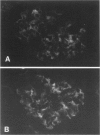Abstract
Injection of antibodies to renal tubular membrane (Fx1A) into Lewis rats induces granular deposits of IgG in glomeruli and proteinuria (passive Heymann nephritis, PHN), and similar lesions are also induced by antibody to one of the antigens in Fx1A, dipeptidyl peptidase IV (DPP IV, gp 108). In this study, the role of DPP IV in PHN was investigated using DPP IV-deficient F344 rats. The amount of DPP IV found in F344 rat kidneys was less than 0.05% of that present in Wistar rats, and injection of anti-DPP IV antibody into F344 rats did not induce proteinuria. Injection of anti-F344 Fx1A rabbit antibodies that contain no detectable anti-DPP IV antibody into Lewis or F344 rats induced PHN, characterized by granular deposits of rabbit IgG in glomeruli and massive proteinuria, although the appearance of proteinuria was delayed in comparison with that occurring in response to injection of anti-Wistar Fx1A antibodies. These results indicate that DPP IV may contribute to, but is not essential for, the induction of PHN.
Full text
PDF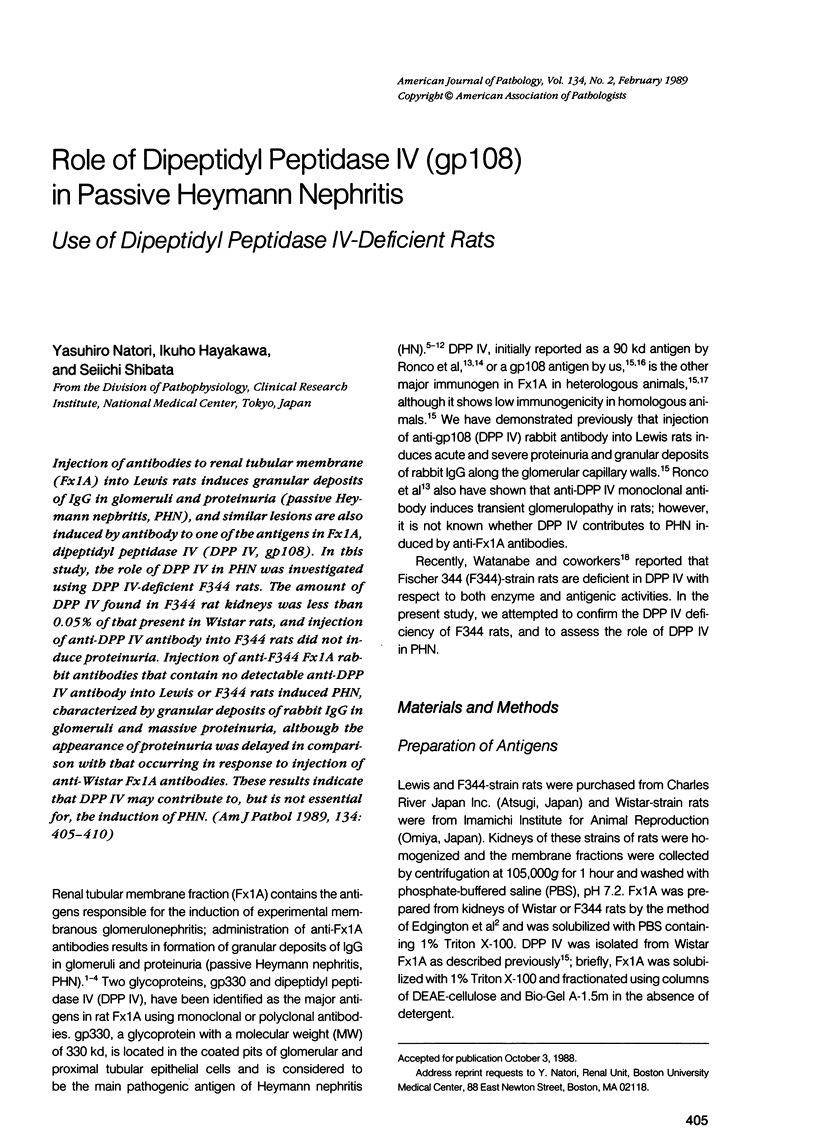
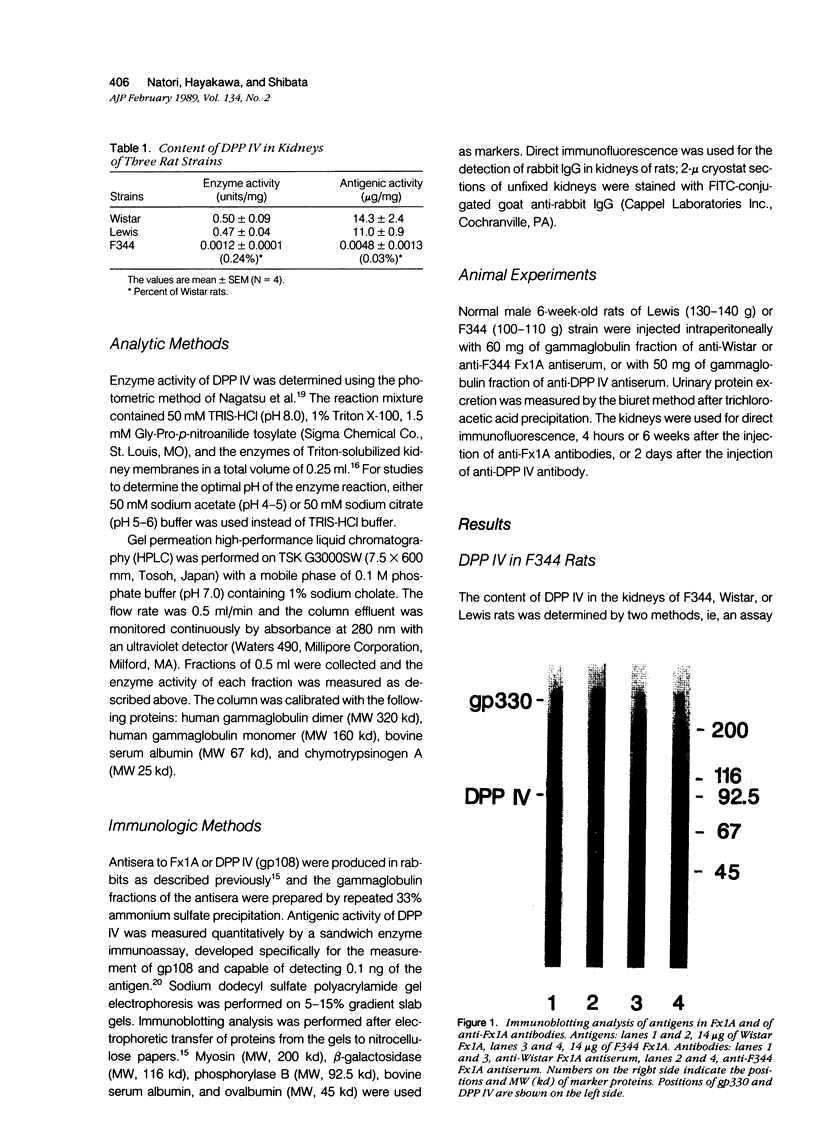
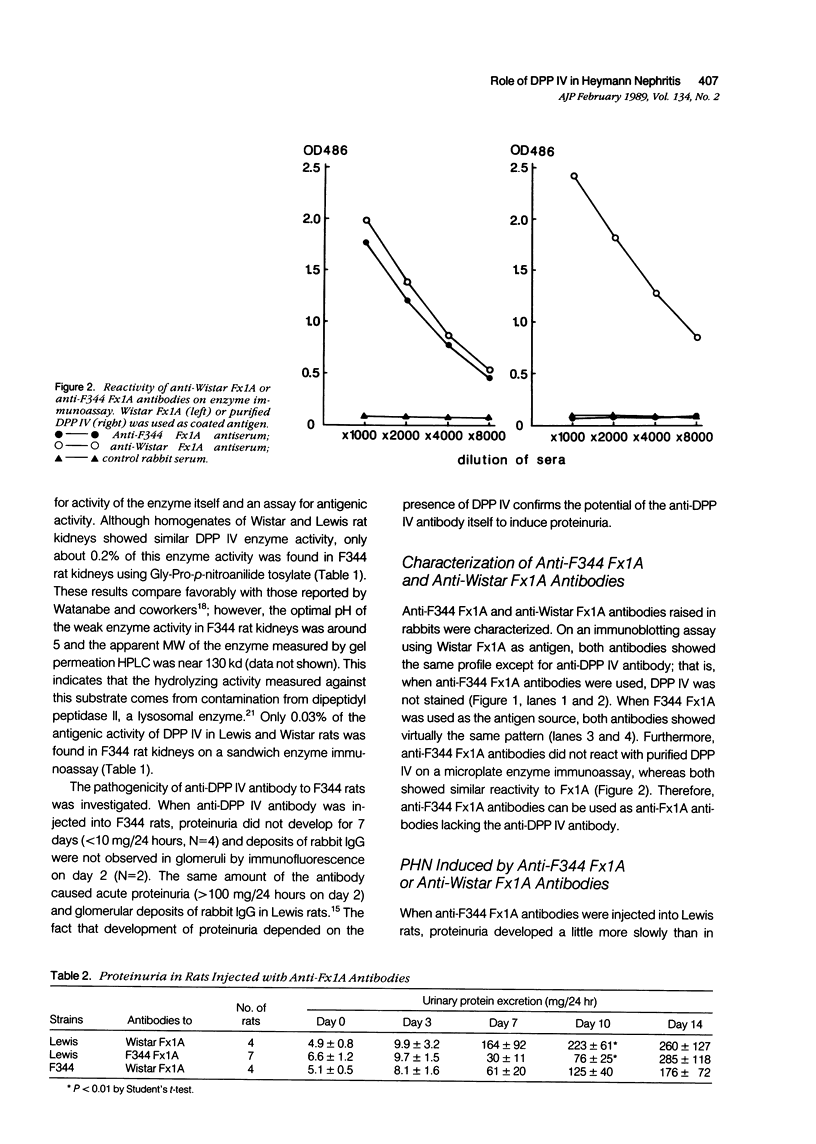
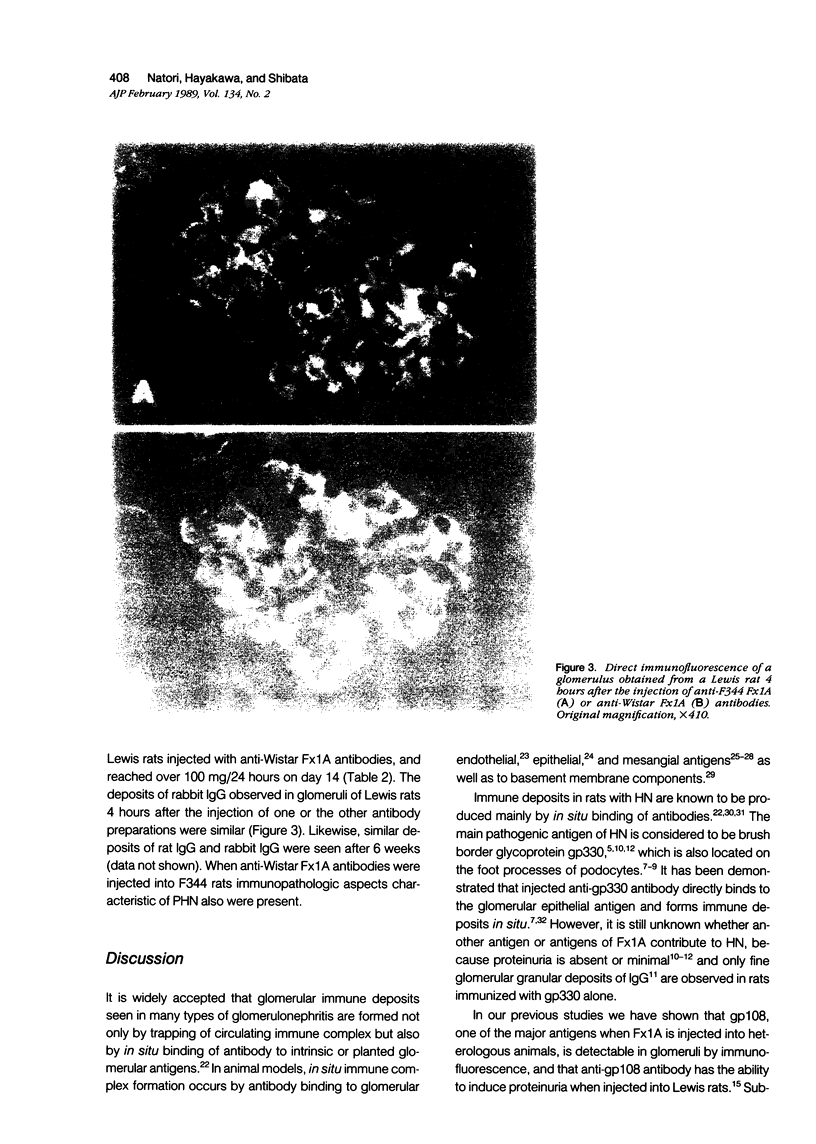
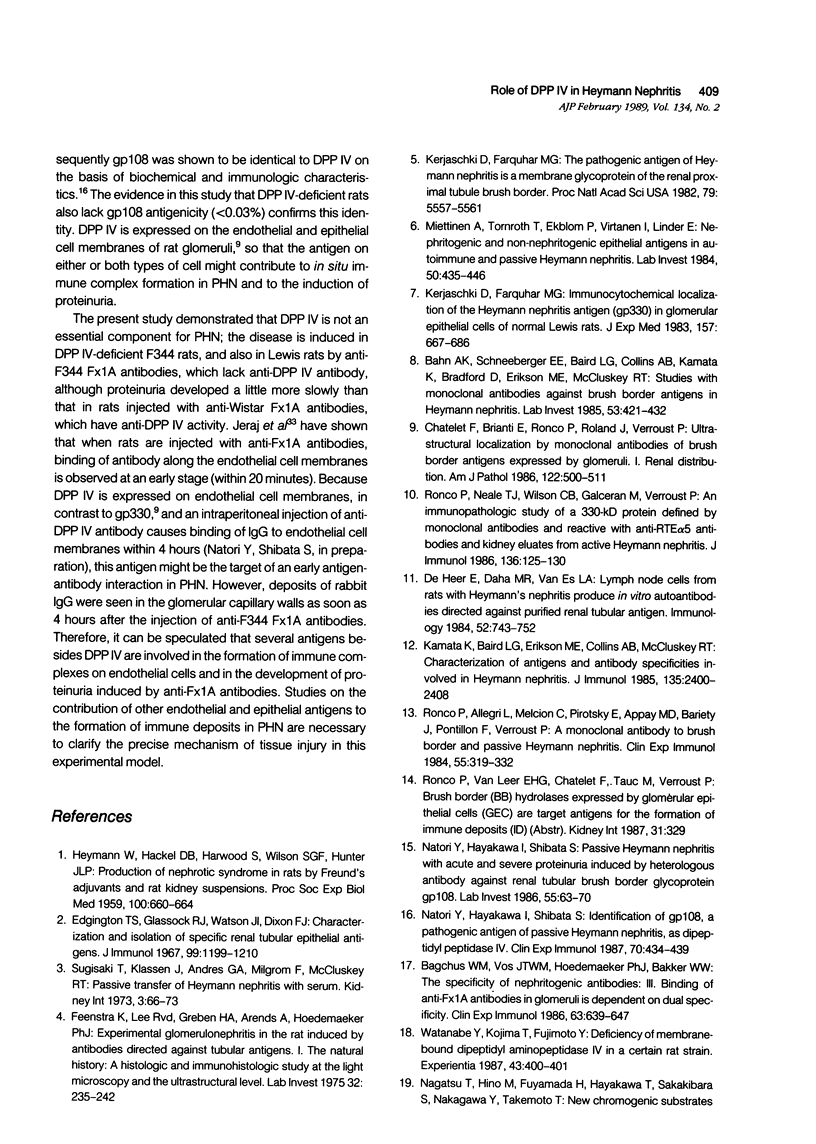
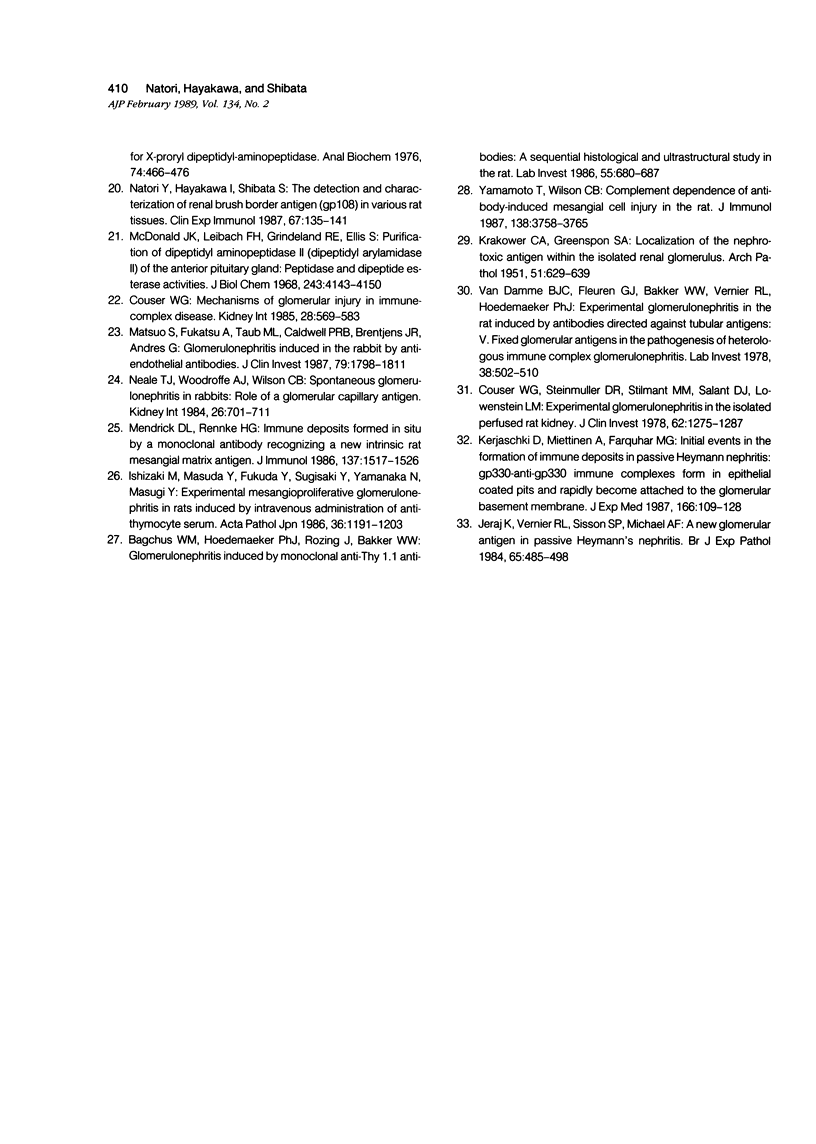
Images in this article
Selected References
These references are in PubMed. This may not be the complete list of references from this article.
- Bagchus W. M., Hoedemaeker P. J., Rozing J., Bakker W. W. Glomerulonephritis induced by monoclonal anti-Thy 1.1 antibodies. A sequential histological and ultrastructural study in the rat. Lab Invest. 1986 Dec;55(6):680–687. [PubMed] [Google Scholar]
- Bagchus W. M., Vos J. T., Hoedemaeker P. J., Bakker W. W. The specificity of nephritogenic antibodies. III. Binding of anti-Fx1A antibodies in glomeruli is dependent on dual specificity. Clin Exp Immunol. 1986 Mar;63(3):639–647. [PMC free article] [PubMed] [Google Scholar]
- Bhan A. K., Schneeberger E. E., Baird L. G., Collins A. B., Kamata K., Bradford D., Erikson M. E., McCluskey R. T. Studies with monoclonal antibodies against brush border antigens in Heymann nephritis. Lab Invest. 1985 Oct;53(4):421–432. [PubMed] [Google Scholar]
- Chatelet F., Brianti E., Ronco P., Roland J., Verroust P. Ultrastructural localization by monoclonal antibodies of brush border antigens expressed by glomeruli. I. Renal distribution. Am J Pathol. 1986 Mar;122(3):500–511. [PMC free article] [PubMed] [Google Scholar]
- Couser W. G. Mechanisms of glomerular injury in immune-complex disease. Kidney Int. 1985 Sep;28(3):569–583. doi: 10.1038/ki.1985.167. [DOI] [PubMed] [Google Scholar]
- Couser W. G., Steinmuller D. R., Stilmant M. M., Salant D. J., Lowenstein L. M. Experimental glomerulonephritis in the isolated perfused rat kidney. J Clin Invest. 1978 Dec;62(6):1275–1287. doi: 10.1172/JCI109248. [DOI] [PMC free article] [PubMed] [Google Scholar]
- Edgington T. S., Glassock R. J., Watson J. I., Dixon F. J. Characterization and isolation of specific renal tubular epithelial antigens. J Immunol. 1967 Dec;99(6):1199–1210. [PubMed] [Google Scholar]
- Feenstra K., van den Lee R., Greben H. A., Arends A., Hoedemaeker P. J. Experimental glomerulonephritis in the rat induced by antibodies directed against tubular antigens. I. The natural history: a histologic and immunohistologic study at the light microscopic and the ultrastructural level. Lab Invest. 1975 Feb;32(2):235–242. [PubMed] [Google Scholar]
- HEYMANN W., HACKEL D. B., HARWOOD S., WILSON S. G., HUNTER J. L. Production of nephrotic syndrome in rats by Freund's adjuvants and rat kidney suspensions. Proc Soc Exp Biol Med. 1959 Apr;100(4):660–664. doi: 10.3181/00379727-100-24736. [DOI] [PubMed] [Google Scholar]
- Ishizaki M., Masuda Y., Fukuda Y., Sugisaki Y., Yamanaka N., Masugi Y. Experimental mesangioproliferative glomerulonephritis in rats induced by intravenous administration of anti-thymocyte serum. Acta Pathol Jpn. 1986 Aug;36(8):1191–1203. doi: 10.1111/j.1440-1827.1986.tb02839.x. [DOI] [PubMed] [Google Scholar]
- Jeraj K., Vernier R. L., Sisson S. P., Michael A. F. A new glomerular antigen in passive Heymann's nephritis. Br J Exp Pathol. 1984 Aug;65(4):485–498. [PMC free article] [PubMed] [Google Scholar]
- KRAKOWER C. A., GREENSPON S. A. Localization of the nephrotoxic antigen within the isolated renal glomerulus. AMA Arch Pathol. 1951 Jun;51(6):629–639. [PubMed] [Google Scholar]
- Kamata K., Baird L. G., Erikson M. E., Collins A. B., McCluskey R. T. Characterization of antigens and antibody specificities involved in Heymann nephritis. J Immunol. 1985 Oct;135(4):2400–2408. [PubMed] [Google Scholar]
- Kerjaschki D., Farquhar M. G. Immunocytochemical localization of the Heymann nephritis antigen (GP330) in glomerular epithelial cells of normal Lewis rats. J Exp Med. 1983 Feb 1;157(2):667–686. doi: 10.1084/jem.157.2.667. [DOI] [PMC free article] [PubMed] [Google Scholar]
- Kerjaschki D., Farquhar M. G. The pathogenic antigen of Heymann nephritis is a membrane glycoprotein of the renal proximal tubule brush border. Proc Natl Acad Sci U S A. 1982 Sep;79(18):5557–5561. doi: 10.1073/pnas.79.18.5557. [DOI] [PMC free article] [PubMed] [Google Scholar]
- Kerjaschki D., Miettinen A., Farquhar M. G. Initial events in the formation of immune deposits in passive Heymann nephritis. gp330-anti-gp330 immune complexes form in epithelial coated pits and rapidly become attached to the glomerular basement membrane. J Exp Med. 1987 Jul 1;166(1):109–128. doi: 10.1084/jem.166.1.109. [DOI] [PMC free article] [PubMed] [Google Scholar]
- Matsuo S., Fukatsu A., Taub M. L., Caldwell P. R., Brentjens J. R., Andres G. Glomerulonephritis induced in the rabbit by antiendothelial antibodies. J Clin Invest. 1987 Jun;79(6):1798–1811. doi: 10.1172/JCI113021. [DOI] [PMC free article] [PubMed] [Google Scholar]
- McDonald J. K., Leibach F. H., Grindeland R. E., Ellis S. Purification of dipeptidyl aminopeptidase II (dipeptidyl arylamidase II) of the anterior pituitary gland. Peptidase and dipeptide esterase activities. J Biol Chem. 1968 Aug 10;243(15):4143–4150. [PubMed] [Google Scholar]
- Mendrick D. L., Rennke H. G. Immune deposits formed in situ by a monoclonal antibody recognizing a new intrinsic rat mesangial matrix antigen. J Immunol. 1986 Sep 1;137(5):1517–1526. [PubMed] [Google Scholar]
- Miettinen A., Törnroth T., Ekblom P., Virtanen I., Linder E. Nephritogenic and non-nephritogenic epithelial antigens in autoimmune and passive Heymann nephritis. Lab Invest. 1984 Apr;50(4):435–446. [PubMed] [Google Scholar]
- Natori Y., Hayakawa I., Shibata S. Identification of gp108, a pathogenic antigen of passive Heymann nephritis, as dipeptidyl peptidase IV. Clin Exp Immunol. 1987 Nov;70(2):434–439. [PMC free article] [PubMed] [Google Scholar]
- Natori Y., Hayakawa I., Shibata S. Passive Heymann nephritis with acute and severe proteinuria induced by heterologous antibody against renal tubular brush border glycoprotein gp108. Lab Invest. 1986 Jul;55(1):63–70. [PubMed] [Google Scholar]
- Natori Y., Hayakawa I., Shibata S. The detection and characterization of renal brush border antigen (gp108) in various rat tissues. Clin Exp Immunol. 1987 Jan;67(1):135–141. [PMC free article] [PubMed] [Google Scholar]
- Neale T. J., Woodroffe A. J., Wilson C. B. Spontaneous glomerulonephritis in rabbits: role of a glomerular capillary antigen. Kidney Int. 1984 Nov;26(5):701–711. doi: 10.1038/ki.1984.205. [DOI] [PubMed] [Google Scholar]
- Ronco P., Allegri L., Melcion C., Pirotsky E., Appay M. D., Bariety J., Pontillon F., Verroust P. A monoclonal antibody to brush border and passive Heymann nephritis. Clin Exp Immunol. 1984 Feb;55(2):319–332. [PMC free article] [PubMed] [Google Scholar]
- Ronco P., Neale T. J., Wilson C. B., Galceran M., Verroust P. An immunopathologic study of a 330-kD protein defined by monoclonal antibodies and reactive with anti-RTE alpha 5 antibodies and kidney eluates from active Heymann nephritis. J Immunol. 1986 Jan;136(1):125–130. [PubMed] [Google Scholar]
- Sugisaki T., Klassen J., Andres G. A., Milgrom F., McCluskey R. T. Passive transfer of Heymann nephritis with serum. Kidney Int. 1973 Feb;3(2):66–73. doi: 10.1038/ki.1973.13. [DOI] [PubMed] [Google Scholar]
- Van Damme B. J., Fleuren G. J., Bakker W. W., Vernier R. L., Hoedemaeker P. J. Experimental glomerulonephritis in the rat induced by antibodies directed against tubular antigens. V. Fixed glomerular antigens in the pathogenesis of heterologous immune complex glomerulonephritis. Lab Invest. 1978 Apr;38(4):502–510. [PubMed] [Google Scholar]
- Watanabe Y., Kojima T., Fujimoto Y. Deficiency of membrane-bound dipeptidyl aminopeptidase IV in a certain rat strain. Experientia. 1987 Apr 15;43(4):400–401. doi: 10.1007/BF01940426. [DOI] [PubMed] [Google Scholar]
- Yamamoto T., Wilson C. B. Complement dependence of antibody-induced mesangial cell injury in the rat. J Immunol. 1987 Jun 1;138(11):3758–3765. [PubMed] [Google Scholar]
- de Heer E., Daha M. R., van Es L. A. Lymph node cells from rats with Heymann's nephritis produce in vitro autoantibodies directed against purified renal tubular antigen. Immunology. 1984 Aug;52(4):743–752. [PMC free article] [PubMed] [Google Scholar]




